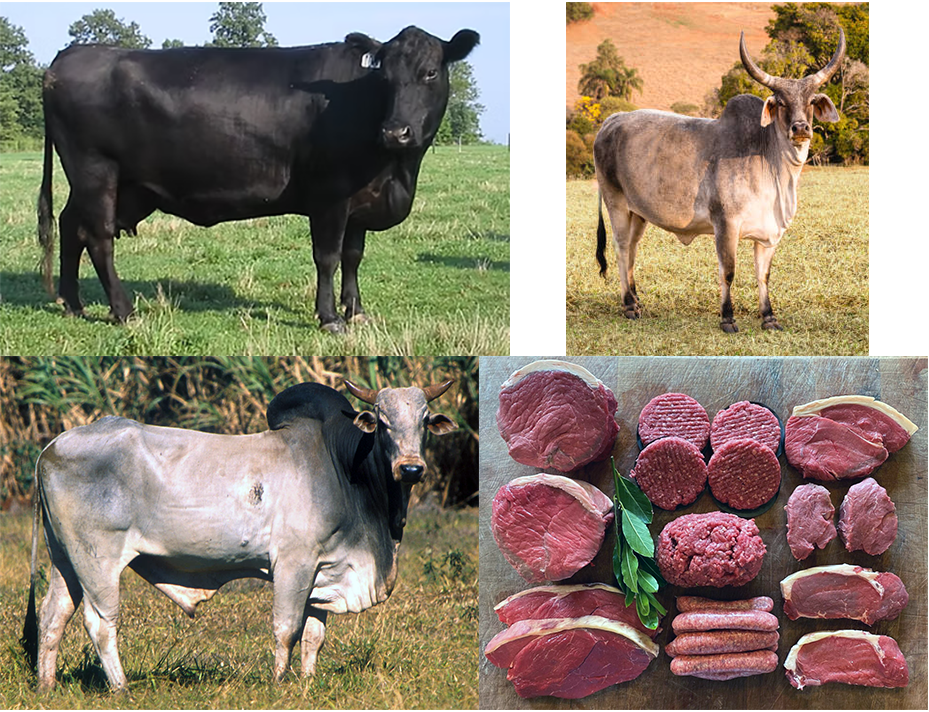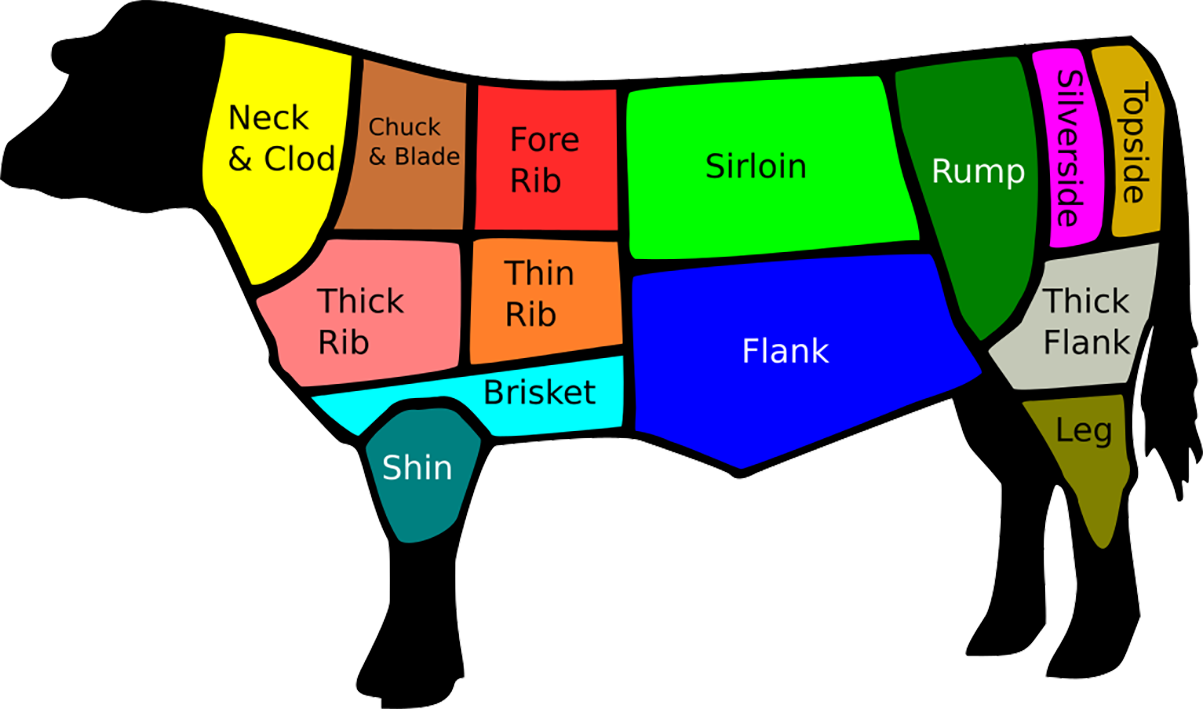FabulousFusionFood's Beef-based Recipes 9th Page
 Image of an European cow (top left), African Zebu (top right) and
Image of an European cow (top left), African Zebu (top right) andIndian bull (bottom left) along with a selection of beef cuts.
Welcome to FabulousFusionFood's Beef-based Recipes Page — The recipes presented here are all based on cow meat. Beef is the culinary name for meat from cattle (Bos taurus or Bos indicus). Beef can be prepared in various ways; cuts are often used for steak, which can be cooked to varying degrees of doneness, while trimmings are often ground or minced, as found in most hamburgers. Beef contains protein, iron, and vitamin B12. Along with other kinds of red meat, high consumption is associated with an increased risk of colorectal cancer and coronary heart disease, especially when processed. Beef has a high environmental impact, being a primary driver of deforestation with the highest greenhouse gas emissions of any agricultural product.
People have eaten the flesh of bovines since prehistoric times; some of the earliest known cave paintings, such as those of Lascaux, show aurochs in hunting scenes. People domesticated cattle to provide ready access to beef, milk, and leather. Cattle have been domesticated at least twice over the course of evolutionary history. The first domestication event occurred around 10,500 years ago with the evolution of Bos taurus. The second was more recent, around 7,000 years ago, with the evolution of Bos indicus in the Indian subcontinent. There is a possible third domestication event 8,500 years ago, with a potential third species Bos africanus arising in Africa.
Most beef can be used as is by merely cutting into certain parts, such as roasts, short ribs or steak (filet mignon, sirloin steak, rump steak, rib steak, rib eye steak, hanger steak, etc.), while other cuts are processed (corned beef or beef jerky). Trimmings, on the other hand, which are usually mixed with meat from older, leaner (therefore tougher) cattle, are ground, minced or used in sausages. The blood is used in some varieties called blood sausage. Other parts that are eaten include other muscles and offal, such as the oxtail, liver, tongue, tripe from the reticulum or rumen, glands (particularly the pancreas and thymus, referred to as sweetbread), the heart, the brain (although forbidden where there is a danger of bovine spongiform encephalopathy, BSE, commonly referred to as mad cow disease), the kidneys, and the tender testicles of the bull (known in the United States as calf fries, prairie oysters, or Rocky Mountain oysters). Some intestines are cooked and eaten as is, but are more often cleaned and used as natural sausage casings. The bones are used for making beef stock. Meat from younger cows (calves) is called veal. Beef from steers and heifers is similar.
he word beef is from the Latin word bōs, in contrast to cow which is from Middle English cou (both words have the same Indo-European root *gʷou-). This is one example of the common English dichotomy between the words for animals (with largely Germanic origins) and their meat (with Romanic origins) that is also found in such English word-pairs as pig/pork, deer/venison, sheep/mutton, and chicken/poultry (also the less common goat/chevon). Beef is cognate with bovine through the Late Latin bovīnus. The rarely used plural form of beef is beeves.
Cuts of Beef (British, Irish,Australian, South African and New Zealand terms):
 Cuts of Beef:
Cuts of Beef:Tongue — boiling, pickling, roasting or braising
Necks and clod — stewing, slow smoking or braising
Chuck steak & blades — mincing, braising, slow roasting
Sirloin — Frying, roasting, barbecuing
Rump — Frying, barbecuing
Silverside — Roasting
Topside — Roasting, pies, air drying
Top rump — Roasting, barbecuing
Fore rib — Roasting
Rib eye steak — Frying
T-bone steak — Frying
Thick rib — Braising, barbecuing, roasting
Thin rib — Braising, barbecuing
Brisket (Skirt steak) — Baking, boiling, roasting, braising
Shin and leg — Mince, slow stewing, braising
Flank — Barbecued, grilled, braised
Thick flank — Barbecued, grilled, braised
Feather blade — Frying, braising
Fillet — Frying, tartare
Oxtail — Stew, braising
Offal — typically liver, heart, stomach, intestines and kidneys
The alphabetical list of all the beef-based recipes on this site follows, (limited to 100 recipes per page). There are 860 recipes in total:
Page 9 of 9
| Toad-in-the-Hole Origin: British | Ugandan Kabobs Origin: Uganda | Vulvae [et] Steriles (Sterile Sow's Womb) Origin: Roman |
| Tomatillo and Beef Curry Origin: Fusion | Ugandan Matooke Origin: Uganda | Vulvam ut Tostam (Grilled Sterile Sow's Womb) Origin: Roman |
| Tomato Keema (Tomato and Beef Curry) Origin: Pakistan | Ukrainian Sausage from Lviv Origin: Ukraine | Wastels yfarced (White Bread, Stuffed) Origin: England |
| Topcheta Corba (Meatball Soup) Origin: Bulgaria | Uruguayan Tuco Origin: Uruguay | Whole Meat Mould Origin: England |
| Topside Pot Roast with Port and Root Vegetables Origin: Britain | Vaca Atolada (Beef Ribs with Cassava) Origin: Brazil | Wiener Schnitzel (Breaded Veal Cutlets) Origin: Austria |
| Tortellini di Natale (Christmas Tortellini) Origin: Italy | Varenga (Roast, Shredded, Beef) Origin: Madagascar | Willowherb Bubble and Squeak Origin: Britain |
| Toto-kena Misy Anana sy Voanjo (Greens with Peanuts and Minced Beef) Origin: Madagascar | Vary Amin'anana (Rice with Greens and Minced Beef) Origin: Madagascar | Wouré Burakhè Magilinri (Sweet Potato Leaf Sauce) Origin: Guinea |
| Tournedos Rossini (Fillet Rossini) Origin: France | Vary Amin'Anana (Hot Pepper Beef) Origin: Madagascar | Xarba Arbija (Libyan Soup) Origin: Libya |
| Tournedos Rossini Origin: France | Veal Curry with Bananas Origin: Uganda | Xavier Steak Origin: American |
| Traditional Cornish Pasty Origin: Cornwall | Vermicelles (Vermicelli) Origin: Mauritania | Yambo Origin: Aruba |
| Traditional Kitfo (Ethiopian Steak Tartar) Origin: Ethiopia | Viande Nyembwe (Meat Nyembwe) Origin: Gabon | Yaprak Sarmasi (Vine Leaf Rolls) Origin: Turkey |
| Traditional Pot Roast Origin: Britain | Victorian Beef Kofta Curry Origin: Anglo-Indian | Yaroa Dominicana Origin: Dominican Republic |
| Traditional Sloppy Joes Origin: American | Victorian Beef Tikka Kebab Origin: Anglo-Indian | Youvarlakia Soupa Avgolemono (Meatball Soup with Egg and Lemon) Origin: Greece |
| Traditional Spaghetti Bolognese Origin: Italy | Victorian Beef Vindaloo Origin: Anglo-Indian | Yuk Gae Jang (Spicy Beef and Vegetable Soup) Origin: Korea |
| Trimlestown Roast Sirloin Origin: Ireland | Virgin Islands Pates Origin: British Virgin Islands | Zanzibar Pilau Origin: Tanzania |
| Trini Meat Patties Origin: Trinidad | Virgin Islands Pates Origin: US Virgin Islands | Zigni (Eritrean Spiced Meat Stew) Origin: Eritrea |
| Trinidadian Pepper Pot Origin: Trinidad | Vitellina fricta (Fried Veal) Origin: Roman | Zimbabwean Sorpotel Origin: Zimbabwe |
| Tripe and Onions Origin: England | Vitulinam sive Bubulam cum Porris (Veal or Beef with Leeks) Origin: Roman | Zom (Bitter Greens with Meat) Origin: Cameroon |
| Tripe Soup Origin: Britain | Vulvae Steriles (Sterile Sows' Wombs) Origin: Roman | Zupa Chrzanowa (Polish Horseradish Soup) Origin: Poland |
| Tsebhi Sega (Spicy Minced Meat) Origin: Eritrea | Vulvae [et] Steriles (Sterile Sow's Womb) Origin: Roman | Žuvies kukuliai (Fish Dumplings) Origin: Lithuania |
Page 9 of 9